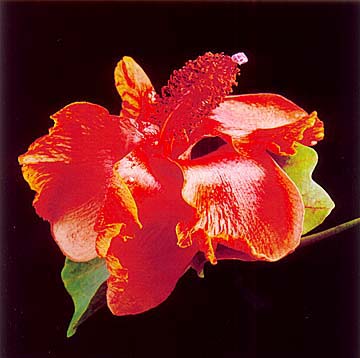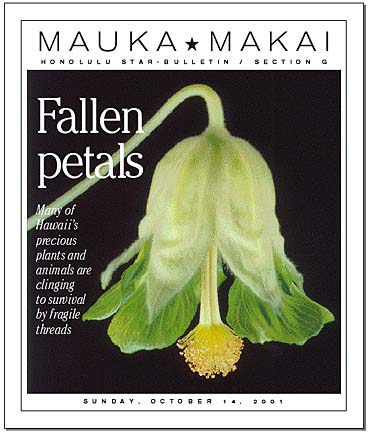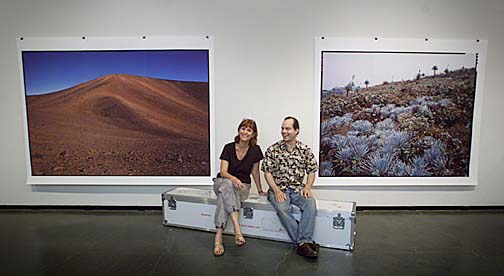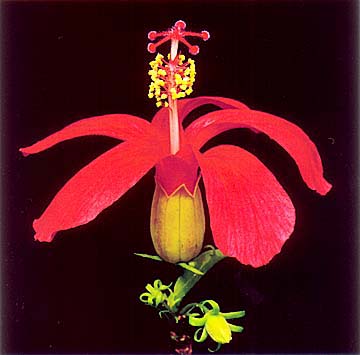


Local Color![]()
Sunday, October 14, 2001

THE DEFINING MOMENT of their career came in February 1993 when David Liittschwager and Susan Middleton learned the story of the singular survivor of Kokia cookei, or Cooke's koki'o, the Molokai species of the Hawaiian endemic cotton trees. Portraits from
extinction’s brinkCOVER STORY
The two photographers, working on their second book on endangered species, were well versed in the stories of many imperiled flora and fauna. But they had never heard a story quite like that of the fragile Hawaiian tree, barely clinging to existence as a graft onto another tree. That was the only way it could survive -- as it was too weak to rely on its own roots.
The Kokia cookei is a hibiscus relative unique to Hawaii. Once it grew abundantly in the lowland forests on Molokai and produced spectacular, large orange red blossoms with ruffled petals.

The early Hawaiians found the bark and the flowers useful for medicine and dye. A Hawaiian honeycreeper, now extinct, fed on the nutrient-rich nectar of the flowers.
"Rare Plants and Animals of Hawai'i," photographs by David Liittschwager and Susan Middleton: REMAINS OF A RAINBOW
On view: Honolulu Academy of Arts
Dates: Opens Thursday and runs through Dec. 30; hours are 10 a.m. to 4:30 p.m. Tuesday through Saturday, 1 to 5 p.m. Sunday
Admission: $7; $4 for seniors, students and military; free to members and children
Call: 532-8700
THE BOOK
The photos are published in an over-sized book, "Remains of a Rainbow" (National Geographic):
For sale: $65 at the Academy Gift Shop and various book stores.
Reading and book signing: Noon to 1 p.m. today, Borders Ward Centre. Call 596-8194.
SLIDE LECTURES
Middleton and Liittschwager share their behind-the-scene stories and insights into the endangered floral and fauna of Hawaii:
Today: 2 p.m. in the Academy Theater. Cost is $5, or $3 for members. Reception and book signing follow the lecture.
Tomorrow: 3 to 7 p.m. at the National Tropical Botanical Gardens on Kauai.
The trees died off as their natural habitat was denuded by free-ranging cattle and goats. A year before the last tree in the wild died, George P. Cooke, a plantation manager, collected fruits and flowers from the lone survivor and propagated a tree for his back yard.
For more than 60 years, Cooke's progeny was the very last of the once abundant tree until Keith Woolliams from Waimea Arboretum took an interest in the 1970s in saving the Kokia cookei. A brush fire that swept through Cooke's back yard killed his tree, but as luck would have it, Woolliams had collected its seeds a few months earlier.

Woolliams succeeded in sprouting one seedling. But when it matured, its seeds were infertile and could not produce another generation of trees. His effort to grow new trees from cuttings and air-layering failed.Finally, a few of his experiments worked after he grafted cuttings onto a related species from the Big Island. Those grafts led to more grafts, and the Kokia cookei was saved -- at least for now. Currently, there are 15 Kokia cookei, all of which are grafts with no genetic variability, leaving them vulnerable to diseases and pests.
"It just dawned on us that this tree tells the story of how precarious life can be for native Hawaiian species. It was like a light bulb going off in our heads; we knew we had to come back to Hawaii to tell the plight of the endangered native plants and animals of Hawaii," Middleton said.
The two award-winning photographers finished up their project on endangered plants and animals of the United States, which included photographing the Kokia cookei. The tree they photographed in 1993 never flowered and eventually died. They did not get to see the explosive red blossoms of the Kokia cookei until 1998, when they returned for the Hawaii project.
The Hawaii project took about five years, with two years of intense full-time picture taking, resulting in an exhibition of stunning photographs, a book and a 30-minute film, all of which are debuting in Hawaii.
The three-year traveling exhibit, "Remains of a Rainbow," opens Thursday at the Honolulu Academy of Arts and continues through Dec. 30. The film, documenting the arduous behind-the-scenes process, will be shown continuously in the exhibition gallery. The book by the same title is for sale for $65 at the Academy Shop and bookstores.

"These photographs differ from the usual nature photography in that we are really making portraits of the bugs, fish, birds, ferns. We want to make pictures that are compelling. We want everything to look heroic and memorable, even monumental," Middleton said.Middleton and Liittschwager, both having worked in the studio of Richard Avedon, famed for his portraiture, are known for using elaborate studio techniques to achieve the look of formal portraits of plants and animals. They use complicated lighting and black velvet to create a jet-black background for the critters and plants, large cameras to capture the minute details of their sometimes tiny subjects.
The two packed their equipment, weighing 65 to 75 pounds, and hiked into the Ko'olaus to search out animals and plants. They always worked with scientific experts who guided them and helped them collect live specimens.
Their studios were often temporary setups in the wild, and a good photograph often took several days to materialize. They took care not to harm the animals, gently confining them in a Plexiglas box for photographing.
"These photographs are the results of an extremely good lens, a lot of patience, a lot of film and a lot of luck, which is generated from a lot of perseverance," Liittschwager said.

Photographing rare Hawaiian forest birds in the wild posed an insurmountable challenge, and the two made special arrangements to photograph the endangered birds at the Keauhou Bird Conservation Center in Volcano on the Big Island.They were lucky when it came to photographing the nene goose and the Hawaiian hoary bat. The Honolulu Zoo had both, and the animal models were tame and cooperative.
The plants, however, posed unexpected danger. Middleton and Liittschwager discovered the challenge of slippery and steep mountain slopes while they looked for the plants.
"People always asked us what is the most dangerous animal we ever photographed, and we've photographed bison, panthers and grizzly bears. I always tell them they don't know what danger is until they find themselves on razor-like ridges on the top of mountains in Hawaii," Middleton said.
But the rewards outweigh the danger. The face-to-face encounters with rare Hawaiian species and the opportunity to document them with dramatic photographs are once-in-a-lifetime experiences, they said.
"With so many exquisitely beautiful plants and animals that have evolved in Hawaii and are found nowhere else on earth, Hawaii really is the crown jewel of our country's natural heritage," Middleton said.
"The sad thing is, Hawaii is home to more than 25 percent of the species on the U.S. endangered species list. If our work helps more people realize that, then maybe we can save more of these elegant and intriguing species."
Gardening Calendar
Suzanne Tswei's art column runs Sundays in Today.
You can write her at the Star-Bulletin,
500 Ala Moana, Suite 7-210, Honolulu, HI, 96813
or email stswei@starbulletin.com